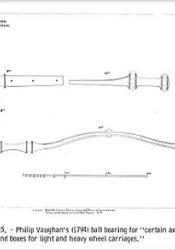The First Bearing Patent and Modern Bearings
A welsh inventor, Philip Vaughan, was the first person to patent ball bearings in 1794, almost 300 years after da Vinci’s notebooks discussed practically identical designs. Vaughan’s design was specifically purposed for reducing friction between the axle and wheel of a carriage. It was then another 100 years before Henry Timken patented tapered roller bearings and founded Timken Roller Bearing Company, which remains the elite standard for bearing manufacturing today.
It is unfortunate that the culture in which da Vinci was inventing did not enable inventors to stake claim on their work as patents do today. Present-day industry recognizes inventors such as Vaughan and Timken as the fathers of bearings, when in fact it was Leonardo da Vinci who hundreds of years earlier documented his observations and improved upon the rudimentary designs of the ancient world. Much of the fame given to Vaughan and Timken comes from their ability to build on da Vinci’s works and implement immediately usable mechanical solutions in the height of the industrial revolution. Da Vinci’s designs while innovative, were not fully realizable given the technologies available to him in the late 15th century. However, his proposed uses such as his flying machine was only able to be envision with knowledge of bearing use and design.
Even today, 500+ years after da Vinci’s work, tribology (the study of friction, wear, lubrication and bearing design) remains a billion dollar industry where many scientists and engineers work to continue to make improvements to bearing design. The persistence of the importance of bearings in machine design speaks to the genius of da Vinci to have theorized and exampled such work much earlier in history.
Sources: “Timken Company.” Wikipedia, 23 Feb. 2018. Wikipedia, https://en.wikipedia.org/w/index.php?title=Timken_Company&oldid=827283421.

